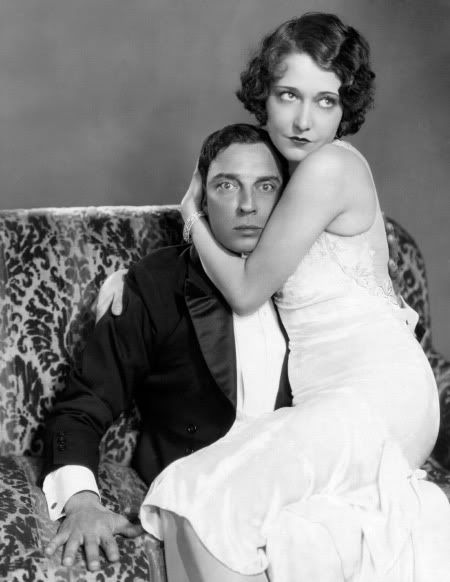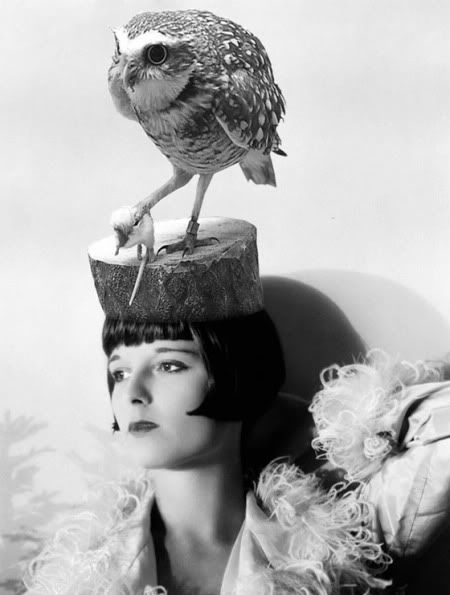26 April 2010
20 April 2010
High and Dizzy
I was gonna post about today being Harold Lloyd's birthday... but I got high. Harold looks pretty high in that picture, come to think of it.
17 April 2010
That Daniels Woman
 Considering the duration and breadth of her career, it's both somewhat surprising and a rotten shame that Bebe Daniels is not a better known figure. Beginning with a part as Dorothy Gale in one of the earliest screen adaptations of The Wizard of Oz at the age of nine, Bebe Daniels worked for nearly half a century in silent and talking pictures, radio, stage and television (according to IMDB, she appeared in over 200 films). More impressive still is the fact that she managed to have two children and maintain a long and by all accounts happy marriage (which, in show business, is quite an achievement in and of itself!).
Considering the duration and breadth of her career, it's both somewhat surprising and a rotten shame that Bebe Daniels is not a better known figure. Beginning with a part as Dorothy Gale in one of the earliest screen adaptations of The Wizard of Oz at the age of nine, Bebe Daniels worked for nearly half a century in silent and talking pictures, radio, stage and television (according to IMDB, she appeared in over 200 films). More impressive still is the fact that she managed to have two children and maintain a long and by all accounts happy marriage (which, in show business, is quite an achievement in and of itself!).Bebe's career began in earnest in the 1910s, when she appeared opposite Harold Lloyd in his highly popular series of Lonesome Luke comedies (for a time the two were simply known as "the boy" and "the girl," and there is much to suggest that they were also romantically involved off-screen). Soon afterward she went to work for Cecil B. Demille, appearing in support of such luminaries as Gloria Swanson and Wallace Reid. She spent much of the 1920s as one of Paramount Pictures' biggest names. Her output in this period was impressive: she appeared in five or six pictures per year (1924 was particularly busy for her -- she appeared in no fewer than nine pictures that year).
In the maelstrom caused by the transition from silent pictures to talkies, Bebe was cut from the Paramount roster. The joke, as it turned out, was on Paramount -- Bebe quickly signed with RKO Pictures and make her talking (and singing!) debut in the film adaptation of Florenz Ziegfeld's Rio Rita, which was one of the biggest box office hits of 1929. Her talents were again showcased in 1930's Dixiana, another adaptation of a Ziegfeld musical (you can read my reviews of these moves, if you're interested). After this brief but profitable stint at RKO, Bebe signed with Warner Brothers, where she appeared in a number of memorable roles, among them Ruth Wonderly in the original screen adaptation of The Maltese Falcon and Broadway prima donna Dorothy Brock in 42nd Street.
Although Bebe largely retired from the screen in 1935, her career as an entertainer did not end there. In that same year, she moved to London with her husband Ben Lyon, whom she had married in 1930. The pair starred in the popular radio show Hi Gang!, which they continued to broadcast during the Battle of Britain and the London Blitz. They continued in radio after the war with Life With the Lyons, a popular comedy show that ran from 1951 to 1961, and enjoyed a leap to television in 1955.
Her life off the screen was no less colorful. In 1921, she spent ten days in jail for speeding. Shortly after her release, she made light of the incident by appearing in a picture called The Speed Girl. She was also awarded the Presidential Medal of Freedom by Harry Truman for her services during World War II.
Unfortunately, an agonizingly small portion of Bebe's films seem to have survived to this day; her silent pictures, in particular, have a very poor rate of survival (sadly, this seems to be true of much of Paramount's library of silent pictures, perhaps because of the copyright limbo in which those numerous films are adrift. Most, it is likely, are lost). What films of hers do survive reveal an actress of considerable talent and range, and no small degree of charm. In that respect, I suppose that posterity ought to count itself lucky that any of Bebe's curriculum vitae has survived the ravages of time at all.
13 April 2010
When a Man Loves (1927)
 That he is able to take what is on the surface a standard-issue costume drama and make it truly engaging to the viewer speaks volumes about John Barrymore's screen presence and acting ability. This is amply demonstrated in When a Man Loves (1927), when would have been only a middle-of-the-road period picture without him. Certainly, the picture's production values are top-notch, from the Vitaphone orchestral soundtrack to the lavish costumes, but it's the unique energy that John Barrymore brings to the production that really makes it worth watching.
That he is able to take what is on the surface a standard-issue costume drama and make it truly engaging to the viewer speaks volumes about John Barrymore's screen presence and acting ability. This is amply demonstrated in When a Man Loves (1927), when would have been only a middle-of-the-road period picture without him. Certainly, the picture's production values are top-notch, from the Vitaphone orchestral soundtrack to the lavish costumes, but it's the unique energy that John Barrymore brings to the production that really makes it worth watching.Originally based on the 1731 novel Manon Lescaut, the screenplay was substantially rewritten to make John Barrymore's Fabien des Grieux the primary focus of the story rather than Mlle. Lescaut herself, played by Dolores Costello in this screen adaptation. Perhaps as a result of this rewrite, Dolores is left without much to do in this picture beyond standing around in gaudy 18th century costumes looking crestfallen (although she admittedly does a pretty good job of this).
The picture begins with both Fabien and Manon on their way to join the life ecclesiastic -- Fabien is on the verge of joining the priesthood, while Manon is slated to be cloistered in a convent. These plans, as you might have imagined, quickly go awry. Fabien falls in love with Manon at first sight, symbolically dropping a pendant given to him to protect him from the temptations of the flesh. Manon, meanwhile, learns that her brother is plotting to sell her into prostitution (the evil brother is here played by Warner Oland, who always seems to play these sort of characters, Charlie Chan notwithstanding). Adventure ensues as Fabien and Manon escape to Paris together, and are separated and reunited time and again through a series of unfortunate twists of fate.
Throughout the picture, one cannot help but notice a recurring theme regarding Manon's virginity and the safeguarding thereof. That she is a virgin is established at the outset of the picture by the fact that she is en route to the nunnery. Shortly after that revelation, a kitten is shown hiding under Manon's skirts (throughout the early parts of the picture, Manon keeps this kitten tucked safely in a basket). Eventually, this kitten winds up in the care of Fabien, with instructions to "take very good care of Fifi!". It's extremely tempting to read this cat as a metaphor for ...well, a pussy of a very different sort. Furthermore, Fabien spends much of the film trying to keep a variety of unsavory characters from having their way with Manon (everyone from a Parisian guttersnipe to the captain of a prison ship to King Louis XV of France himself tries to get into Manon's petticoats).
That's taking care of Fifi for you. But let's get our minds out of the gutter.
Throughout all of this, it's John Barrymore who truly carries the picture. He gives the character of Fabien des Grieux an air of gravitas that few of his contemporaries could match, and plays the action scenes with a mania that makes the character significantly more likable than he might otherwise be (I imagine that des Grieux might seem a bit too noble if played by a matinee idol like Ramon Novarro). Whether fencing with French noblemen or leading an uprising on a prison ship bound for Louisiana, Barrymore's Fabien is zealous without being over the top. The rest of the acting is solid, even by the largely ornamental Dolores Costello, but When a Man Loves is undeniably John Barrymore's show.
It's a show worth watching if you get a chance.
Filed Under:
Dolores Costello,
double entendres,
film reviews,
John Barrymore
10 April 2010
08 April 2010
Have You Got Any Castles? (1938)
Here's another one of those cartoons that I must have watched countless times when I was a kid. I'm willing to bet that you saw it a few times, too. As is to be expected from a cartoon of this era, celebrity caricatures abound in Have you Got Any Castles? -- no doubt you'll be able to spot Clark Gable, William Powell and Cab Calloway, among others. The highlight of the cartoon, though, might be its extremely memorable, swing-laden soundtrack. Do give this one a watch.
Subscribe to:
Posts (Atom)


